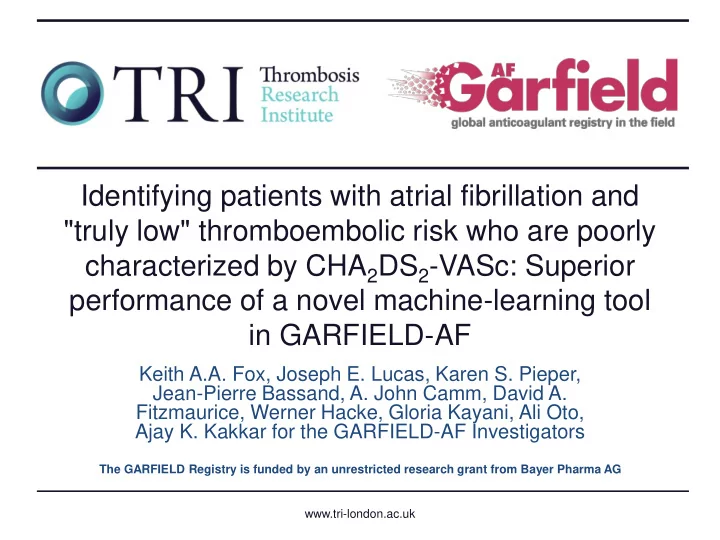

Identifying patients with atrial fibrillation and "truly low" thromboembolic risk who are poorly characterized by CHA 2 DS 2 -VASc: Superior performance of a novel machine-learning tool in GARFIELD-AF Keith A.A. Fox, Joseph E. Lucas, Karen S. Pieper, Jean-Pierre Bassand, A. John Camm, David A. Fitzmaurice, Werner Hacke, Gloria Kayani, Ali Oto, Ajay K. Kakkar for the GARFIELD-AF Investigators The GARFIELD Registry is funded by an unrestricted research grant from Bayer Pharma AG www.tri-london.ac.uk
Background and Context • The role of anticoagulation for patients with AF and ≥ 1 risk factor for stroke/systemic embolism is defined by trial evidence and guidelines • Between 2010-2011 and 2014-2015, anticoagulation usage rose from 57% to 71% of patients with AF • However, the balance of risk and benefit is poorly defined for “low risk’ AF 100 90 Proportion of patients, % 80 70 60 50 40 30 20 10 0 Cohort 1 Cohort 2 Cohort 3 Cohort 4 2010 – 11 2011 – 13 2013 – 14 2014 – 15 (n=5311) (n=11,562) (n=11,343) (n=10,923) VKA VKA+AP FXaI FXaI+AP DTI DTI+AP AP None Camm AJ et al . Heart 2016 (in press) www.tri-london.ac.uk
How are low and high risk AF patients managed in practice? • Contrary to international guideline recommendations, – 28% high-risk patients (CHA 2 DS 2 -VASc ≥2) are not anticoagulated – 51% of very low-risk patients (CHA 2 DS 2 -VASc 0) are anticoagulated ≥2 CHA 2 DS 2 -VASc 0 1 100 90 Proportion of patients, % 80 None 70 AP 60 DTI+AP DTI 50 FXaI+AP 40 FXaI 30 VKA+AP 20 VKA 10 0 (n=352) (n=1336) (n=9027) Camm AJ et al . Heart 2016 (in press) www.tri-london.ac.uk
How are low and high risk AF patients managed in practice? • Contrary to international guideline recommendations, – 28% high-risk patients (CHA 2 DS 2 -VASc ≥2) are not anticoagulated – 51% of very low-risk patients (CHA 2 DS 2 -VASc 0) are anticoagulated ≥2 CHA 2 DS 2 -VASc 0 1 100 90 Proportion of patients, % 80 None 70 AP Factors beyond those in current risk scores appear to influence 60 DTI+AP DTI 50 prescribing decisions on anticoagulation, including risk of bleed FXaI+AP 40 FXaI 30 VKA+AP 20 VKA 10 0 (n=352) (n=1336) (n=9027) Camm AJ et al . Heart 2016 (in press) www.tri-london.ac.uk
Purpose: To provide accurate estimates of risk as the basis of decisions on prescribing or withholding anticoagulation Aim: To derive and validate a more accurate and user- friendly method of stratifying patients according to risks of death, stroke and bleeding www.tri-london.ac.uk
Statistical Methods: The GARFIELD Score A “machine learning” approach to risk modelling • Coalescent regression avoids the need to specify levels of relatedness in the statistical model, it allows joint modeling of all outcomes. • Models were based on 38984 patients in GARFIELD 2010 to 2015 for: – all-cause mortality, – ischaemic stroke/thromboembolism, and – haemorrhagic stroke/major bleed that occurred within 1-year of enrolment into GARFIELDAF. • Also, a simplified model was also derived to facilitate web applications • The performance of both models were compared with CHA 2 DS 2 -VASc in all patients and those with a low risk of stroke • External validation was undertaken using an independent contemporary registry ORBIT-AF www.tri-london.ac.uk
Number of events in low- and higher-risk patients at 1 year Number of events determined using one year Kaplan-Meier rates Event Low risk* Higher risk ( n=7 861; 20.2%) (n=31 123) All-cause mortality 94 (1.4%) 1387 (4.9%) Ischaemic stroke/ Systemic embolism 35 (0.5%) 396 (1.4%) Haemorrhagic stroke/ Major bleed 26 (0.4%) 295 (1.1%) • Low risk patients (defined as CHA2DS2-VASc 0 or 1 for men and 1 or 2 for women) represent 20.2% of overall cohort • Total number of patients: 38,984 enrolled between March 2010 and July 2015 www.tri-london.ac.uk
GARFIELD Score performance characteristics in all patients Ischaemic stroke / Haemorrhagic stroke / All-cause mortality Systemic embolism Major bleed C statistic: 0.78 C statistic: 0.63 C statistic: 0.67 www.tri-london.ac.uk
Comparison of GARFIELD Score with CHA 2 DS 2 -VASc in all patients Performance Event GARFIELD Score CHA 2 DS 2 -VASc measure C statistic All-cause mortality 0.78 0.66 Ischaemic stroke / systemic embolism 0.63 0.63 Haemorrhagic stroke / major bleed 0.67 0.61 www.tri-london.ac.uk
Comparison of GARFIELD Score with CHA 2 DS 2 -VASc in low-risk patients CHA 2 DS 2 -VASc 0 or 1 for men and 1 or 2 for women Performance Events GARFIELD CHA 2 DS 2 -VASc measure Score C statistic All-cause mortality 0.72 0.56 Ischaemic stroke / Systemic embolism 0.62 0.56 Haemorrhagic stroke / Major bleed 0.72 0.57 www.tri-london.ac.uk
Performance of the new simplified GARFIELD Score in patients enrolled in GARFIELD-AF and ORBIT-I Population Endpoint C Statistic Events (n / N) (95% CI) GARFIELD-AF Ischaemic stroke/SE 0.70 (0.68, 0.73) 438 / 38,607 ORBIT-I Any stroke/SE 0.69 (0.64, 0.75) 91 / 9,743 GARFIELD-AF Haemorrhagic stroke/major bleed 0.68* (0.64, 0.72) 187 / 12,249 1 ORBIT-I Major bleed 0.61 (0.58-0.64) 625 / 7,442 *C statistic for HAS-BLED is 0.64 (95% CI 0.59, 0.68) 1. Evaluation of a subset of patients who were prescribed oral anticoagulants in countries where at least 1% bleeding rate was recorded www.tri-london.ac.uk
Conclusions • Performance of GARFIELD Score was superior to CHA 2 DS 2 -VASc in predicting ischaemic stroke or major bleed in all patients, and those with a low risk of stroke • This integrated risk tool has the potential for incorporation in routine electronic systems www.tri-london.ac.uk
Next steps • A simplified GARFIELD Score, validated using data from ORBIT-AF, is being developed, with web-based and mobile device applications* • The GARFIELD Score may help physicians assess the appropriateness of anticoagulation in low-risk patients * http://colab-sbx-322.oit.duke.edu:3338/ www.tri-london.ac.uk
BLEEDING SCORE 20% Risk of major bleed in 1 year
Recommend
More recommend